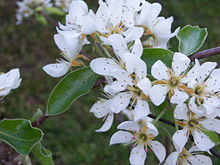Alexander Lucas
The Pear Alexander Lucas ( Pyrus communis 'Alexander Lucas'), and 'Lucas Alexander', was first in 1874 by the nursery Transon in Orléans grown and spread after they have been in a forest in a few years Blois in France was discovered by the eponymous Alexandre Lucas was. The name first used in France was Beurré Alexandre Lucas. It is very robust, hardly suffers from diseases and is therefore widespread in gardens, especially since it combines a melting fruit with a good aroma.
tree
The tree grows moderately and can be trained in all tree shapes. Flowering begins mid-early, the petals overlap or do not touch. As it is a triploid variety with a triple set of chromosomes, Alexander Lucas is not a suitable pollinator for other pear trees, but otherwise accepts pollen from almost all other Pyrus forms (including ornamental pears, Asian pears, etc.). Sometimes parthenocarpic fruits develop, so that yield is possible even when the flowers are frozen.
fruit
The fruit is large and weighs around 150 to 250 grams, it hangs on a short, thick stem. The shape is broad pear-shaped to conical with a smooth shell. The basic color is a light green, when fully ripe it is also light yellow with an orange spot on the sunny side. The light yellow to whitish flesh is melting and juicy, but a little grainy. The taste is sweet, with little acidity, the aroma is judged to be only mediocre. The small core sits near the calyx side of the fruit.
Harvest time and storage
The harvest season begins at the beginning of October. The fruits can be stored for around two to three months, and in special cold stores for up to six months. The good storability and the consistently high yield are the main reasons for growing this variety.
See also
literature
- Manfred Fischer (Ed.): Color Atlas of Fruit Types. 2nd, heavily revised edition. Ulmer, Stuttgart 2003, ISBN 3-8001-5547-8 , p. 95.
- Walter Hartmann (Ed.): Color Atlas of Old Fruit Types. 2nd, heavily revised edition. Ulmer, Stuttgart 2003, ISBN 3-8001-4394-1 , p. 180.
Web links
- Index card of the variety in the BUND-Lemgo fruit variety database
- Alexander Lucas at the fruit growing consultancy Baden-Württemberg



